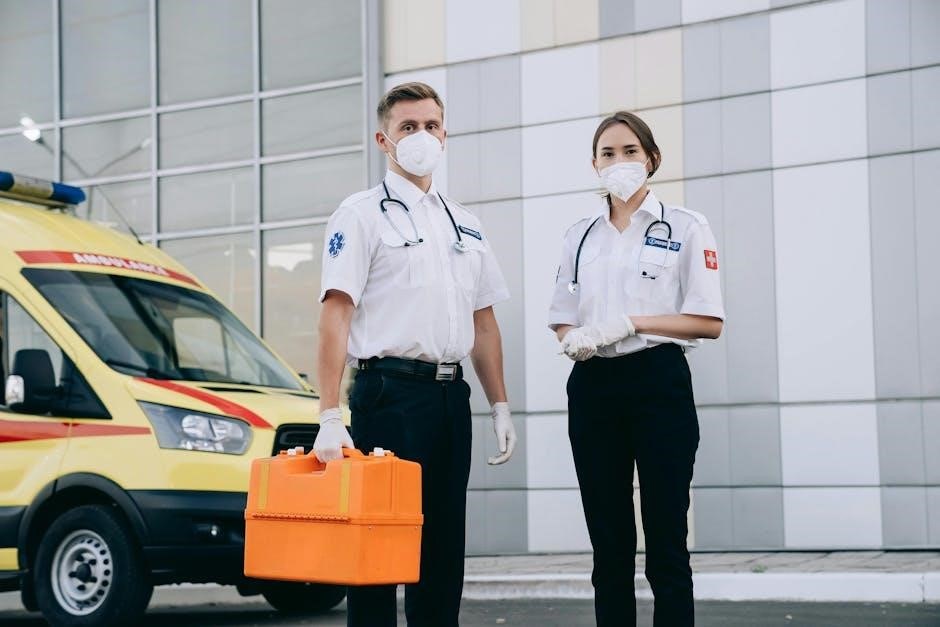Emergency Medical Consent Form PDF: A Comprehensive Guide

An emergency medical consent form PDF is a vital document. It ensures individuals receive prompt treatment when incapacitated. This guide explores its purpose, key components, and benefits, offering free templates for diverse needs and empowering informed healthcare decisions.
What is an Emergency Medical Consent Form?
An Emergency Medical Consent Form is a crucial legal document designed to authorize medical treatment for an individual in situations where they are unable to provide consent themselves. This situation often arises during emergencies, such as when a person is unconscious, incapacitated, or otherwise unable to communicate their healthcare wishes.
The form essentially allows a designated representative, often a family member, friend, or legal guardian, to make medical decisions on behalf of the patient. It outlines the scope of permissible medical interventions, ensuring that healthcare providers can administer necessary treatment without delay while respecting the patient’s autonomy and preferences to the extent known.
This document typically includes vital information about the patient’s medical history, allergies, current medications, and emergency contact details. This information aids healthcare professionals in making informed clinical decisions, even when the patient cannot directly provide it. The form also specifies the extent of the authorization granted, ensuring that medical interventions align with the patient’s best interests.
Having a well-prepared Emergency Medical Consent Form readily available can significantly expedite medical care, potentially saving critical time and improving patient outcomes during emergencies.
Purpose of an Emergency Medical Consent Form
The primary purpose of an Emergency Medical Consent Form is to ensure individuals receive timely and appropriate medical care during emergencies, particularly when they cannot express their wishes. It bridges the gap between a patient’s need for immediate treatment and their temporary inability to provide informed consent.

The form serves as a legal authorization, allowing designated representatives to make healthcare decisions on the patient’s behalf. This authorization ensures that medical professionals can proceed with necessary examinations, procedures, and treatments without facing legal obstacles or delays. By clearly outlining the scope of consent, the form safeguards both the patient’s rights and the healthcare provider’s ability to act swiftly and effectively.
Furthermore, the Emergency Medical Consent Form facilitates efficient communication by providing crucial medical information, such as allergies, medications, and existing conditions. This information is invaluable to healthcare providers, enabling them to make informed decisions that align with the patient’s medical history and minimize potential risks. It ensures informed clinical decisions on patients’ behalf.
Ultimately, the form aims to protect the patient’s well-being by empowering authorized individuals to advocate for their healthcare needs during times of crisis, improving patient outcomes and ensuring access to life-saving medical interventions.

Key Information Included in the Form
An Emergency Medical Consent Form is a structured document designed to capture essential information needed for providing appropriate medical care during emergencies. Several key sections contribute to its comprehensiveness.
It starts with personal information like full name, date of birth, address, and identification details, which are crucial for accurate patient identification and record retrieval. Next, the form includes a detailed section on the patient’s medical history, encompassing pre-existing conditions, allergies (especially drug allergies), current medications (including dosages), and any past surgeries or hospitalizations. This information helps medical professionals avoid adverse reactions and tailor treatment plans effectively.
The form also requires emergency contact details, including the names, phone numbers, and relationships of individuals who should be notified in case of an emergency. These contacts serve as the primary communication link between healthcare providers and the patient’s family or representatives.
Finally, the core of the form is the emergency medical authorization section. Here, the patient (or their legal guardian) designates a person authorized to make medical decisions on their behalf if they are unable to do so. This section specifies the scope of the authorization, any limitations, and the effective period of the consent. Accurate, complete information ensures informed medical decisions.
Personal Information
The “Personal Information” section of an Emergency Medical Consent Form is foundational. It establishes the identity of the individual. This information is crucial for accurate identification, record retrieval, and communication purposes during a medical emergency. This section typically requires details such as the individual’s full legal name, ensuring consistency with medical records and insurance information.
The date of birth is another essential element, confirming age and helping distinguish between individuals with similar names. A current and complete address is necessary for locating the individual’s residence and potentially contacting family members or caregivers. Contact phone numbers, including both mobile and home numbers, are vital for immediate communication with the individual or their emergency contacts.
Furthermore, the form may include fields for additional identifying information, such as a social security number or medical record number, to facilitate efficient access to medical history and insurance details. In cases involving minors or individuals under guardianship, the personal information of the parent or legal guardian is also included, establishing their authority to provide consent. Complete and accurate personal information is paramount for effective emergency response.
Medical History and Current Medications
This section of the Emergency Medical Consent Form is critical. It provides healthcare professionals with essential insights. These insights relate to the patient’s health background and current pharmaceutical regimen. This information is crucial for making informed clinical decisions, especially when the patient is unable to communicate. Detailing pre-existing medical conditions such as diabetes, epilepsy, or heart disease allows first responders to tailor their approach.
Listing all current medications, including dosages and frequency, is vital for preventing adverse drug interactions and ensuring continuity of care. Documenting any known allergies, particularly to medications or substances like latex, is crucial for avoiding potentially life-threatening allergic reactions. Information about past surgeries, hospitalizations, and significant illnesses provides a comprehensive overview of the patient’s medical journey.
Furthermore, the form may include sections for relevant family medical history, which can highlight potential genetic predispositions. Any implanted medical devices, such as pacemakers or insulin pumps, should also be noted. This section ensures healthcare providers have a holistic understanding of the patient’s medical status, enabling them to deliver the safest and most effective treatment possible during an emergency.

Emergency Contact Details
The emergency contact details section of the form is paramount. It ensures healthcare providers can quickly reach designated individuals. These individuals can provide further information or make decisions on the patient’s behalf if they are unable to do so. The primary emergency contact should be someone readily available and familiar with the patient’s medical history.
This section should include the full name, relationship to the patient, and multiple contact numbers. Multiple contact numbers include both a primary phone number and an alternate number. Including an email address can also be beneficial for non-urgent communication. It is advisable to list at least two emergency contacts in case the primary contact cannot be reached.
Furthermore, consider including the contact’s address to facilitate quicker location in certain situations. It is crucial to inform the designated emergency contacts that they have been listed on the form and to ensure they are willing to take on this responsibility. Regularly updating this information is essential to maintain its accuracy. This ensures that in a crisis, healthcare providers can promptly connect with the appropriate individuals to facilitate informed decision-making and support the patient’s well-being.
Emergency Medical Authorization
The emergency medical authorization section is the core of the form. It grants permission to healthcare providers to administer necessary treatment when the patient cannot consent. This section explicitly outlines the scope of authorized medical care. It also addresses any limitations or specific instructions regarding treatment preferences.
This authorization typically covers a broad range of emergency medical interventions deemed necessary. These interventions are necessary to preserve life, prevent serious harm, or alleviate suffering. The form should include a clear statement indicating that the signer authorizes medical personnel to provide treatment. It also states that they will provide treatment in accordance with their professional judgment.
However, it’s crucial to include provisions for specifying any treatments the patient explicitly refuses. This may be due to religious beliefs, personal values, or prior medical directives. The authorization should also address the circumstances under which it becomes effective. It should state whether it applies only when the patient is unconscious or unable to communicate. The signature of the patient (or their legal guardian) and the date are essential to validate the authorization. Regular review and updates ensure the authorization reflects the patient’s current wishes and medical circumstances. This empowers healthcare providers to act swiftly and confidently in critical situations.
Who Needs an Emergency Medical Form?
Emergency medical forms aren’t just for individuals with pre-existing conditions. They are beneficial for a wide range of people in various situations. Parents of young children who are often in daycare or school should complete these forms. This ensures caregivers can make informed decisions about their child’s health in emergencies.
Individuals with chronic illnesses like diabetes, epilepsy, or severe allergies should always carry a completed form. This is especially true if they travel or participate in activities where an emergency is possible. The elderly, who may have complex medical histories or take multiple medications, greatly benefit from having this information readily available.
Furthermore, anyone who anticipates being in a situation where they might be unable to communicate their medical needs should complete the form. Examples of such situations include traveling alone, participating in extreme sports, or undergoing medical procedures. Even healthy adults can benefit from completing an emergency medical form. Unforeseen accidents or sudden illnesses can strike anyone. Having a completed form ensures that medical professionals have access to crucial information. This ensures they can provide the best possible care, regardless of the individual’s age or health status. The forms offer peace of mind and potentially life-saving information in critical moments.
Completing the Form: A Step-by-Step Guide
Completing an emergency medical consent form doesn’t have to be daunting. First, gather all necessary information. Include the patient’s full name, date of birth, address, and insurance details. Accurately record any existing medical conditions, such as diabetes, asthma, or heart problems. List all current medications, including dosages and frequency.
Note any allergies, especially to medications, food, or environmental factors. Provide detailed contact information for at least two emergency contacts. These should be individuals readily available and authorized to make medical decisions. In the emergency medical authorization section, clearly state who is authorized to provide consent. This could be a parent, guardian, spouse, or designated healthcare proxy.
Specify any limitations or preferences regarding medical treatment. For example, if there are religious objections to blood transfusions, note them clearly. Review the completed form carefully to ensure accuracy and completeness. Have the patient, or their legal representative, sign and date the form. Make copies for the patient, emergency contacts, and healthcare providers. Regularly update the form, especially after changes in medical conditions, medications, or emergency contacts. Store the form in an easily accessible location, such as a wallet, purse, or glove compartment. Consider using a digital copy as well, ensuring it is password-protected. By following these steps, you can create a comprehensive and effective emergency medical consent form.
Importance of Accessibility and Storage
The accessibility and storage of an emergency medical consent form are paramount. A meticulously completed form is useless if it cannot be accessed quickly during a crisis. Ensure the form is readily available to those who may need it. This includes family members, caregivers, and potentially first responders.
Consider storing a physical copy in a prominent location at home, such as on the refrigerator or in a designated medical information binder. Carry a copy in your wallet or purse, especially when traveling or participating in activities with potential risks. Inform emergency contacts about the form’s location. This ensures they can provide it to medical personnel if you are unable to do so yourself.
In addition to physical copies, consider creating a digital version. Securely store the digital form on your smartphone or tablet, using password protection or encryption to safeguard sensitive information. Explore medical alert apps that allow you to store and share your emergency medical information with first responders. Regularly review and update the form, particularly after changes in medical conditions, medications, or emergency contacts. Discard old versions of the form to avoid confusion. Make sure the people close to you know where to find the form and how to access it. Accessibility and proper storage can make the difference;
Free Emergency Medical Form Templates
Numerous free emergency medical form templates are available online, offering a convenient starting point for creating your personalized document. These templates come in various formats, including PDF, Word, and Google Docs, catering to different software preferences. When selecting a template, prioritize those from reputable sources, such as healthcare organizations, legal websites, or government agencies. This ensures the template adheres to legal requirements and includes all essential sections.
Carefully review the template to ensure it covers all relevant information, including personal details, medical history, current medications, allergies, emergency contacts, and medical authorization clauses. Customize the template to accurately reflect your specific circumstances. Add or remove sections as needed, and use clear, concise language to avoid ambiguity. Consider templates designed for specific situations. This can include forms for children, adults, or individuals with specific medical conditions.
Remember that while templates provide a helpful framework, they should not replace professional legal advice. Consult with an attorney or healthcare professional if you have any concerns about the form’s content or its suitability for your needs. The ease of having a template is great, but always review the information. Templates can be tailored to your family’s specific needs, so it is a perfect way to get started. Take the time to make sure all of your information is correct.
Benefits for Various Users
Emergency medical consent forms offer diverse benefits across various user groups. For individuals, these forms ensure their healthcare wishes are respected when they cannot communicate. This is particularly crucial for those with chronic conditions, severe allergies, or who are prone to medical emergencies. Parents of minor children benefit significantly, as the form empowers caregivers, schools, and babysitters to make informed medical decisions on their child’s behalf in their absence. It provides peace of mind, knowing their child will receive necessary care.
Healthcare providers gain valuable information through these forms, enabling them to make quicker, more informed clinical decisions. Access to medical history, current medications, and allergies can be life-saving in emergency situations. Schools and daycare facilities rely on these forms to provide appropriate care to students. They ensure staff has the necessary information to respond effectively to medical incidents. Companies also benefit, as the forms allow them to provide prompt assistance to employees experiencing medical emergencies at work. The forms add important information to the employee’s induction documentation.
Furthermore, caregivers for elderly or disabled individuals find these forms indispensable. They facilitate appropriate medical care for those under their charge. In essence, emergency medical consent forms serve as a vital communication tool. They bridge the gap between patients, caregivers, and medical professionals. This ensures that healthcare decisions align with the patient’s wishes and medical needs, ultimately promoting better outcomes for all involved. This is especially true when time is of the essence.
